
Weathering is a natural process that breaks down all minerals and rocks and eventually transform them into soil. Without weathering there will be only rocks making plants, animals and life as we know it impossible. Such transformation leaves recognizable marks on the jade surface of burial jades as they underwent the same process similar to other minerals and rocks in a natural environment. Under a 40X magnification, these weathering marks including amorphous silicate, phyllocilicate clay, dissolution of nephrite crystals, and formation of iron oxides and iron hydroxides can be clearly seen as demonstrated on the Han disc magnified below.
Chemical weathering in relation to burial nephrite jade.Weathering can be divided into physical and chemical weathering. Physical weathering refers to rock breaking apart due to natural forces like exposure to wind and water erosion, climatic heat expansion and contraction, shear force of ice and glacial into exfoliation and so on. Chemical weathering is chemical changes of the minerals in the rocks, induced by surface water, oxygen and carbon dioxide of the atmosphere. The result is the break down of minerals chemically and structurally, releasing cations into the environment, and eventually transform rocks into soil. All rocks contain more than one mineral. All minerals form crystal except when they are in the amorphous phase. A mineral is in amorphous phase when it maintains its chemical composition, but has lost its shape and crystal form. It is often seen in the burial jades as the whitish greyish pasty like material on the jade surface, often mistakenly referred to as calcification. Water is the main medium and the main driving force for chemical weathering. Also important are other variables like a hot, cold, dry or wet climate, the composition of parent minerals with different chemicals and crystal structures, and biological changes bring in by surrounding plants, animals and bacteria in the environment. All these make chemical weathering a very complex process. Chemical weathering is a well studied science in Geology, Geochemistry, Mineralogy, Clay Mineral studies, archeology and Environmental Science. Scientific papers on the subject come from scholars around the world. Changes seen on the burial jade surface so far have eluded explanation which underlies the reason why fake burial jades are so profusely produced. Since most burial jades are nephrite, an amphibole, knowing chemical weathering through these scientific papers on the mafic and felsic rocks; rocks and minerals that are iron rich silicates, provides a path for an authentication solution. Information comes mainly from clay mineral and geology scientific literatures. References are listed at the end of this segment.
The first stage of Chemical weathering and the formation of amorphous silicate.
Chemical weathering can be divided in two stages. Both stages can occur at the same time on the same surface of a mineral rock at various degree due to differences on the surface in drainage, micro pores size, and weakness points on the mineral, namely joints and cracks that can affect the chemical weathering effect. The mineral surface has different points of high energy, points where water flows through or retained. In burial jades high energy points are where the jade surface turns or drops off, the recesses and grooves from lines and cuts, and drill holes on the jade piece. These are areas where most weathering effects take place. Dissolution and leaching is the first stage of weathering. As water comes into contact of the mineral surface, it reacts with the chemical by replacing the cations, and in nephrite, calcium, magnesium and iron, that leach out in a higher ratio than the silicate. The result is the loss of cations and the fibrous nephrite crystals lose their shape and become amorphous. Amorphous silicate has a whitish to greyish color and appears pasty on the jade surface. A protonated surface about 10Å is formed. This is the surface where protonation, in other word the chemical reaction, takes place. Of significance is the protonated surface cannot be cleaned by ultrasound treatment, leaving a permanent mark on the jade surface, and a clue for authentication. (Y. Noack, F. Colin, D. Nahon, J. Delvigne, and L. Michaux. Secondary-Mineral formation during Natural weathering of pyroxene: review and thermodynamic approach. American Journal of Science, Vol. 293, February 1993. P. 111 – 134.) Extensive amorphous silicate formation can be seen on the Zhou (1046 – 256 BCE) jade man shown below. Notice the more heavy concentration of the whitish amorphous silicate beside the raised lines. The lines are positive relieves, formed by cutting down on both sides turning both sides into depressed grooves that retain water. Also when the jade piece was made, it creates fine granules from the cutting and drilling. It is well known in the scientific community that by simply breaking the mineral sample, these fine granules form. ( Mechanism of pyroxene and amphibole weathering – 1, Experimental studies of iron free minerals. Jacques Schotts, Robert A Berner and E Lennert Sjoberg; Geochimica et Comochimica Acta Vol.45, pp. 2123 -2135. 1981) These fine granules when meet with water, go into rapid dissolution skewing the scientific data. To clean them requires washing with a Hydrogen fluoride + Sulfuric acid solution. At the time the jade was made, because of the cutting and drilling, the cut lines and drill holes accumulate a large amount of such granules. These depressions also accumulate water and are high energy points. With more water available, rapid dissolution of these fine granules takes place, resulting in high concentration of the amorphous silicate in these depressions giving them a whitish delineated appearance well known in burial jades . The large amount of fine granules and water accumulation in drill holes also result in large amount of substrate inside the drill hole and formation of unusual secondary mineral products as we should see later. This accumulation of fine granules in the recess areas also can be seen on newly made jade pieces, and the higher concentration of the amorphous silicate in recess areas is greatly imitated by the fake jade makers. Notice also the multiple raised relieves on the surface of the jade man, a phenomena that will be discussed later.
Weathering in the surface micro pores, a reason for color change in burial jades.Weathering occurs on the surface as well as in the micro pore – micro crack system. These micro cracks measure 1µm in width, and as weathering continues lens shape etch pits form parallel to the c axis of the crystal. As more etch pits are formed, they coalesce and the micro pores enlarge widen up to 6µm. Changes on the surface is limited by water penetration, only to 0.05 µm to 0.12 µm, and sets a limit on weathering effect on the surface. Exception to this is in areas of large cracks and joints. These weaknesses allow water to penetrate deeper into the mineral as far as these cracks and joints extend. Clay minerals of the smectite group forms. Because of the size of the micro pores, transformation is at the molecular level, by solid state topotactic mechanism, pesudomorph from nephrite to smectite. Pseudomorph is when a mineral changes into another mineral chemically and physically without changing its shape. Smectite is a clay mineral group with at least 15 members. Their color vary from white to green, dark green close to black, yellow and brown. A yellow clayey plasma is formed. As weathering advances, parent mineral disappears inside the etch pits and voids lined by ferruginous material known as microboxworks form. Boxworks, also call Speleothem, are mineral structure formations when mineral erodes away leaving veins of mother mineral. Boxworks are found often in caves as seen in the picture below from the Elk Room, Wind Cave South Dakota. (Picture from the U S Park Service). As microboxworks

form inside the micropores, they can only seen by electron microscopy. Ferruginous projections called pendants extend from the microboxworks into the void. (MICHAEL ANTHONY VELBEL. WEATHERING OF HORNBLENDE TO FERRUGINOUS PRODUCTS BY A DISSOLUTION-REPRECIPITATION MECHANISM: PETROGRAPHY AND STOICHIOMETRY. Geochimica et Cosmochimica Acta Volume 45, Issue 11, November 1981, Pages 2123-2135.)These microboxwork and pendants exhibit the phenomenon of birefringence, meaning reflective light shine on them can only be seen at a certain angle. Several material exhibit birefringence and crystal is one of them. The specific of birefringence can be used to identify materials especially among minerals. The ferruginous material of the microboxwork are goethite, kaolinite and gibbsite. Smectite can weather into kaolinite. Both are clay minerals and such transformation occurs frequently. Hematite is also frequently found with amphibole weathering depending on the location in the world the parent mineral is from. Hematite is an iron oxide and has color of black, silvery grey, reddish brown and red. Goethite is an iron hydroxide and has color of black, brown, reddish brown and yellow. Kaolinite is a clay mineral with color of white to pale cream and yellow. Smectite has multiple members and they rang from yellow, brown, green and even black, depending on the amount of iron available. These weathering secondary products form inside the micropores and cracks of the nephrite, giving about 0.1 mm of the nephrite surface the color of brown, reddish brown yellow and may even black, the patina color of the burial jades. The Han beast on the left, and the Song frog on the right below have lost their original nephrite color and assume the color of the clay mineral and the iron oxyhydroxide inside their surface micro pores. Chemical weathering is the reason burial jades have such color. Understanding the process is key to identify fakes. When the burial jade pieces are looked at under the microscope obliquely, the color changes from the secondary products can be seen just underneath the surface in the micro pore system, whereas fake jades are dyed from top and remain on the surface.
Secondary products can be seen spilling out from the micro pores to form pin point dots on the jade surface as on the magnified picture below on the curve surface of the Song frog, more noticeable on the right lower corner of the picture.
Chemical weathering on the nephrite jade surface and formation of ferruginous crust and phyllosilicate clay crystals.
Other than inside the micro pore system, dissolution and leaching also occur on the jade surface resulting in etch pits formation as nephrite crystals dissolve. These pits are shallow due to the limit of water penetration. As in the micropores, when more etch pits are formed, they coalesce and enlarge. Amorphous silicate forms from leaching fills these etch pits. The surface of a Hongshan (4700 -2900 BCE) zoomorphic bird woman shown below demonstrates such effect. Notice that on the upper and lower part of the magnified picture on the right shows formation of phyllosilicate which has a yellowish shinny and grease like color with a reddish tint, an indication iron oxyhydroxide also present as weathering advances into the phyllosilicate / oxyhydroxide stage. Phyllosilicates are clay minerals which are silicates with a sheet like crystal structure. They can be divided into 1:1 or 2:1 clay, meaning, to put it simply, is that their structure can be 2 sheets which the Kaolin group belongs to, or 3 sheets which the smectite group belongs to. Recognizing phyllosillicate is important since they are frequently found on the surface of the burial jades.
With time and availability of water and oxygen in the enviroment, smectite forms a brown to yellow pasty plasma on the surface. This plasma like material forms a thin filament crust on top. According to a Polish study, this filament measures 20-30 µm, about 0.2 – 0.3 mm. Because it is transparent, the presence of this filament is hard to recognize till you come across some of the jade pieces that were dropped in the past resulting in cracking of this crust. On one Liangzhgu disc (3400-2250 BC) with a diameter of 2 inches, such filament can be demonstrated. Like all Liangzhu discs, this disc is carved only on one side. The underside is flat. On the front, it slopes down abrutly when it comes to the side making a very sharp edge. Under the microscope, cracks can be seen on a whitish yellowish crust filament that covers the whole jade piece. A small piece of the filament is lost, and through this window, the real jade surface can now be seen (see pictures below). Without the cracks, even under the microscope, it is difficult to recognize this crusty filament. The presence of this filament makes the jade surface looks like it has depth, as if it is under water when look through the microscope. Natural nephrite obtain from an alluvial mine of dried up river bed are encased in a rock like crust formed from a process called encrustation pseudomorph. ( Picture below).
As soon as jade pieces were buried inside a tomb, this encrustation pseudomorph process began. This crust takes hundreds of thousand years to develop, at an estimate 50 thousand years for half a cm. The longest burying time for Chinese burial jade is 7000 years. So the changes observed on the burial jade surface comes only from the early stage of this encrustation pseudomorph process as the buried jade forming the crust. Changes in association with this process occur. With available iron, Goethite/Hematite inclusion form inside the filament as seen on the back of this Zhou jade man below. These inclusions on the burial jade surface are superficial, form within the
smectite plasma filament when free iron from leaching is available. Black Hematite inclusions are also seen in this Han thin dragon below. Black inclusion are more frequently found than red inclusions. Below is a Zhou jade bird with red inclusions within the plasma layer on his crown. Red inclusions are also likely hematite. With progression of the weathering process, sheet like phyllocate (clay crystal), forms on the surface of the jade. They are more solid looking and less grease like as in the amorphous sillicate. These sheet like structures layer out and can have a reddish tint to solid reddish color indicating the presence of iron as seen on the Liangzhu (3400 – 2250 BC) disc below. Notice the demarcation of the phyosillicate (clay crystal) coming down from the upper left corner on the magnified photograph.
The brownish discoloration seen on the axe is due to iron presentation as black specs of hematite inclusions and silvery metal deposits are seen under the microscope (pictures below). The hair like patch on the right upper corner is not an artifact, as it can be found
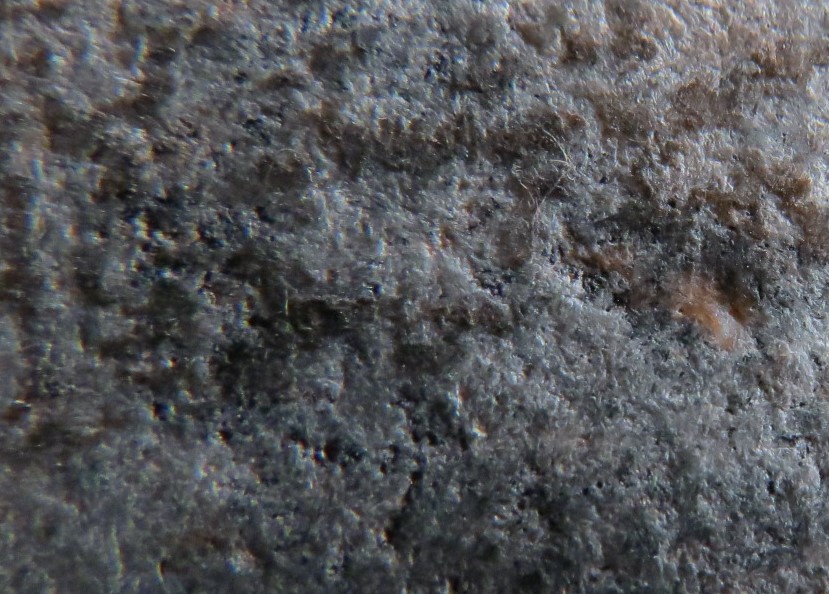
in several other burial jade pieces. The Xia bracelet shown below also has such hair like crystal structures.


The exact nature of this structure is unclear. The closest resemblance is the illite crystal, a non expandable clay.

http://blogs.egu.eu/divisions/sss/files/2014/09/4f97b5df8c8da.jpg
Another possibility is Byssolite, an Amphibole Supergroup, a variation of Actinolite.
https://www.mindat.org/photo-176154.htmlThe presence of clay mineral on the surface of burial jades as a secondary product of chemical weathering, results in a well known phenomenon. It has long been known that some of the burial jades process an odor commonly referred to as the ‘tomb odor’. The odor does not come from the tomb, but from the clay produced on the jade. Clay is one of the few minerals that give out an odor. https://www.scientificamerican.com/article/the-odors-of-minerals/ As clay material is formed on the surface of burial jades from chemical weathering, under certain conditions, such clay will give out an odor that jade collectors are so familiar with, and so mistaken with its origin.
Iron oxide mineral crystal formation on jade surface and in drill holes.
The clay phyllosilicate crystals are greyish in color and sheet like. They are however not the only product from chemical weathering as ferruginous materials are also produced from the weathering process, resulting in iron oxide and hydroxide minerals on the burial jade surface. Below is a Liangzhu plaque covered by a red crust, an indication of
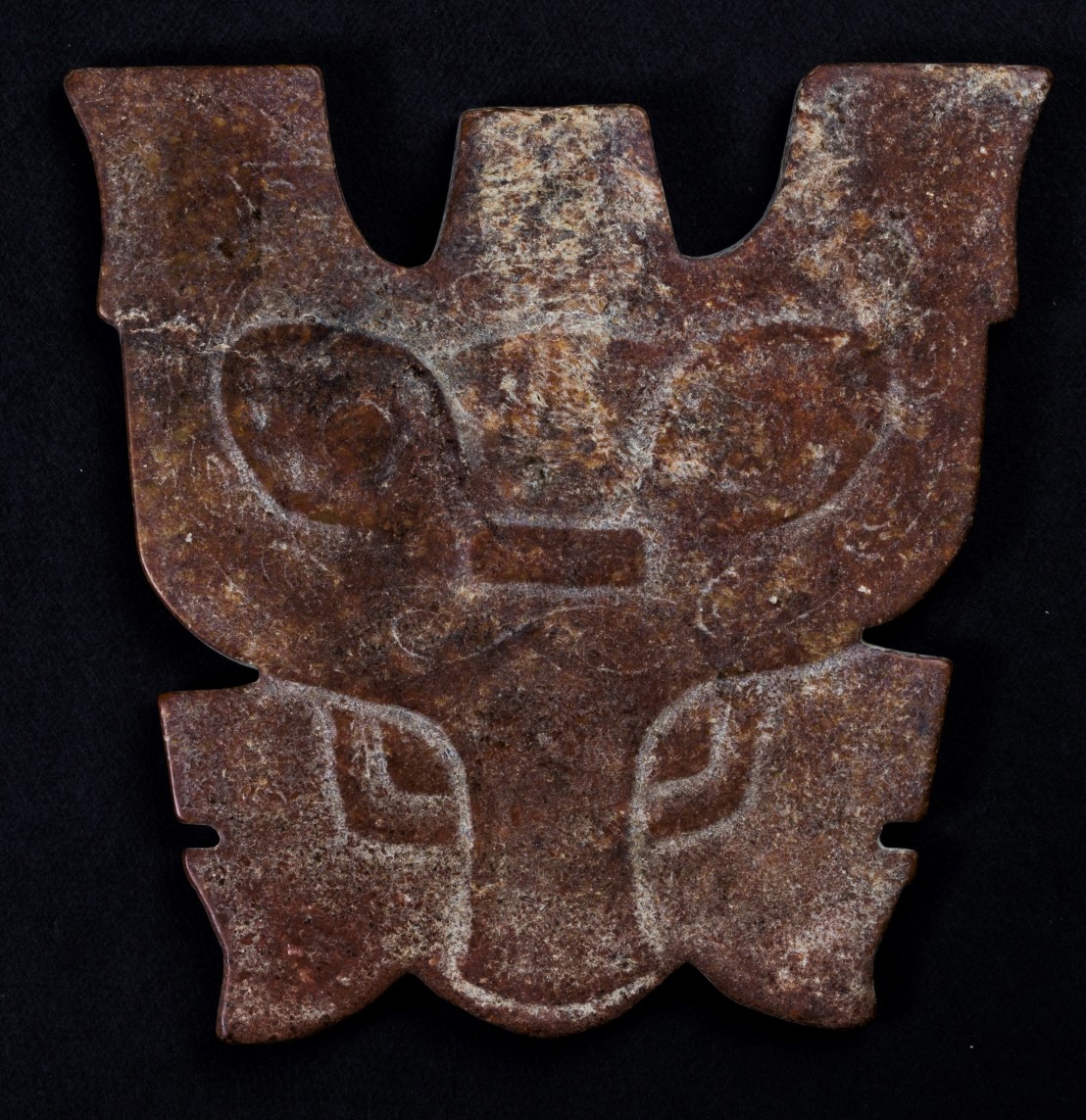
iron. ( As a side note, this plaque is very important in Chinese history, as it can easily link the Hongshan and the Liangzhu culture to the Shang culture, integrating the Chinese culture into a truly 7,000 years one linage descence.) Under the microscope the red mineral forms crystal comparable to natural Hematite mineral as seen on a sample
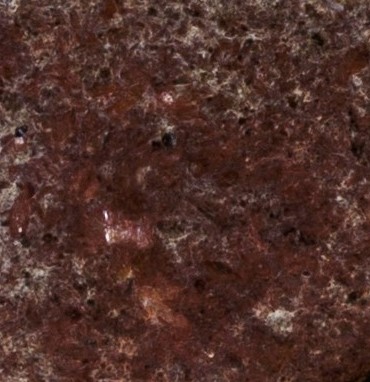
below. (from Sandatlas http://www.sandatlas.org/hematite/ )

Natural Hematite has silvery metal deposits shown clearly in the middle of the sample above. These type of metal deposits are also frequently found on surface of burial jades. The Liangzhu bead below shows such deposit on the upper right of the magnified
photo. These metal deposits appear as droplets, and they all show the birefringence effect, seen only at a certain angle, making finding them a difficult task at time. Below is a Zhou comb that also has the metal droplets on its surface, seen at the center of the magnified view below . Metal droplets in association with the Hematite formation is not the only metallic finding on the burial jade surface. Small pin point like metallic shine with a bright golden yellow color are often seen on Han or older pieces. Unlike the droplets, which appear at random, these metal shines always appear in a line, be it curve or straight, and like the droplets, they also exhibit the birefringence effect. The presence of such lines can be demonstrated on the Hongshan beast below, seen in the middle of the magnified view. This type of metallic line formation can also seen on the Han beast below. The exact nature of these metallic points line is uncertain. However since they always appear in a line, they probably are related to the cleavages of the nephrite jade.As weathering products form on the jade surface they crystalize. Within the drill holes due to the presence of large amount of fine granules from the drilling, and the larger amount of water available, result in a large amount of ferruginous substrate inside a cave like space, and needle like Hematite crystal forms. Below is a Hongshan bird with a worm on its head. Within the drill hole, needle Hematite crystal forms. This is not the
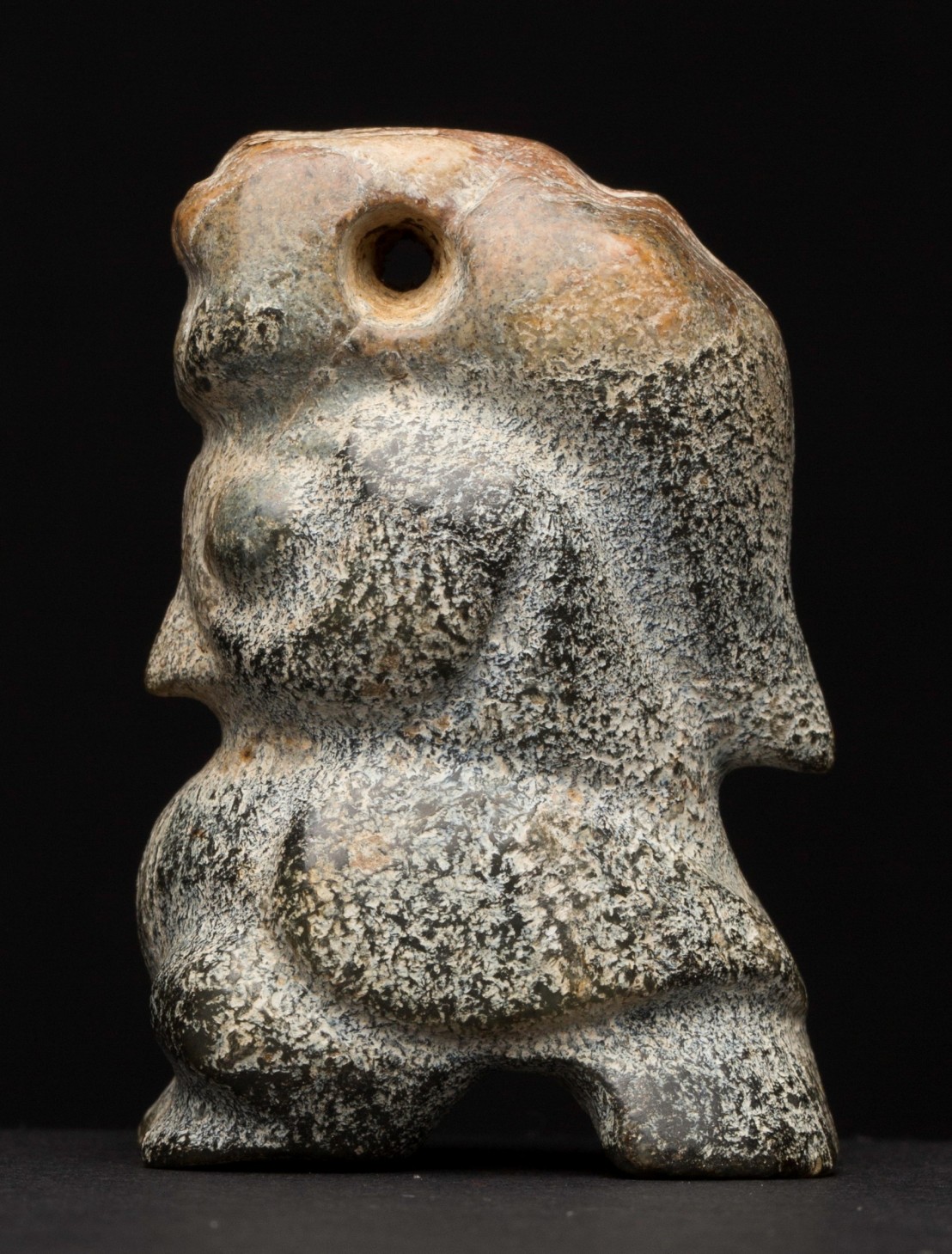
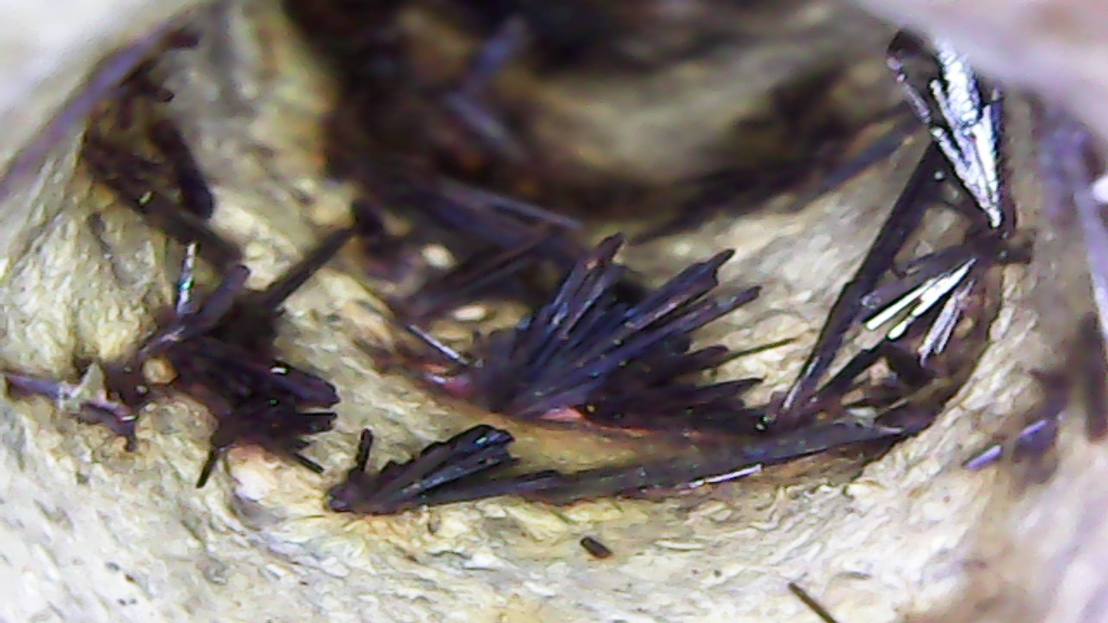
only Hongshan piece that has such crystal formation, indicating such crystals can be found in many genuine Hongshan pieces. Other crystal formations on the surface are more difficult to understand, like on this Hongshan birdman below.
Effect of cleaning on jade surface.Chinese jade collectors have always divided collectable jades into unearthed jades (出土玉), and jades from hereditary (傳世玉), It is difficult to understand why should there be such a division and what puts them apart, until the jades are looked at under the microscope. The unearthed ones retain all the markings from weathering, whereas the hereditary ones were cleaned by previous owners. What can be cleaned on the surface are the clay and ferruginous crust. Once this crust is removed, the protonated layer where the chemical reaction of the weathering process took place is exposed. The protonated layer cannot be clean even with ultra sound cleaning. Also the patina color of the burial jade, caused by the clay and ferruginous material produced inside the surface micro pores cannot be cleaned. Below is a Xia mask that has been cleaned in the
Raised relief on nephrite jade artifact, what it is and confirmation of chemical weathering on Nephrite jades.
The only scientific article exploring burial nephrite jade with regard to geologic mineral changes is “Raised relief on nephrite jade artifacts: observations, explanations and implications. Journal of Arcaeological Science, 40 (2013) 943-954.” by Frederick A. Cook. This is truly an excellent pioneer work in this field that deserves all the respects given to a true insight into the chemical weathering on burial jades. In this article Professor Cook investigates the notion that raised relief can be found on the surface of burial nephrite jades, and the presence of such relief if proven genuine, can be used to confirm the authenticity of the artifact. The article provides confirmation to observations already discussed in this writing. However it also posts other questions that are worth looking into. The article divides the raise relief into two categories. One is a raised crystal, often single, but can be in groups. The other is a patch or areas higher and above the observed jade surface. These patches contain no raised crystal as in the other group, but are made up with fibrous normal nephrite crystals. Judging from the pictures of the artifact specimens in the article, one can easily see that all artifacts except number 4 the Neolithic Bi disc, and number 6 the circular bowl with a stand, the surface has been previously cleaned. (One side note is that judging from the bird headed hunter on the circular bowl, as compared to the bird headed people on the Han disc posted at the beginning of this chemical weathering writing, the circular bowl should be a Han piece and not Tang.) The patches being referred to as raised relief appear to be the remnant of the clay phyllosilicate crust left behind after the previous cleaning. The crust is above the surface, but certainly is not raised, a reason why underneath the patch normal fibrous nephrite crystals are found. Of some interest is specimen number 4, the Neolithic Bi Disc. This disc was not cleaned, and phyllosilicate clay on the surface is obvious, easily seen especially on the magnified view. Part of the disc was under cover from another disc. As a result less water was available on the part of the disc under cover, and that part of the disc has far less weathering effect, and hence far less clay phyllosilicate on the covered part of the disc surface, demonstrating the importance of water in chemical weathering.
Of the two groups, group one has the true raised relief, jades with a crystal on and above the nephrite jade surface. Raised relief are not frequently found, only may be on 5% of the burial jades. When it occurs, they usually are multiple, as seen on the picture of specimen 6 in the Raised Relief article, the circular bowl with a stand. Also by scrolling back to the top third figure of this writing, the Zhou jade man, one can see the raised relief on the surface are also multiple. Multiplicity of the raised relief is also the case on the three Hongshan jade pieces shown below. The first one is a squatting monster man
with its raised relief magnified shown below. Notice the similarity of the raised relief on the monster man and those found on the circular bowl on figure 6. The next is a C-dragon with raised relief as shown below. When comparing the raised relief on the C-dragon and the monster man, one should put into consideration that the C- dragon measures 15 cm in length, whereas the monster man is only 4 cm in height. The size of the raised relief on the two pieces may be comparable. There are however differences between the two types of raised relieves. Those on the c-dragon are black

with silvery metal deposit on many of them, whereas those on the monster man are lighter in color with no metal deposit found. The third raised relief example is on a squatting beast shown below. The raised relief on the beast are also different from the

raised relief on the other two Hongshan pieces. Unlike those on the other two that are crystals in a cluster, those on the squatting beast are individual crystals. They also differ in texture, smooth with a Smokey semi transparent color and no metal deposit, a resemblance to Smoke Quartz. The differences between the raised relief on all three pieces indicate that they are probably different mineral crystals. There may be more than one kind of crystal forming raised relief.
The raised relief was thoroughly investigated scientifically in the article. Thin slides made from specimen 6, the bowl with stand, were chosen for petrographic microscopy and electron microprobe examination and analysis. The raised relief selected is a single pyroxene crystal, a diopside on the jade surface. There are other diopside crystals found, all at or near the surface of the bowl. The assumption is that these pyroxene crystals are formed during the nephrite metamorphic formation. As the nephrite was pushed from the crust of the earth to the surface, hydrothermal alteration continues the alteration of the diopside to tremolite. Since the pyroxene was present during metamorphism when the nephrite was formed, it has to be inside the nephrite before the jade piece was carved. If such is the case, the diopside should be found any where inside the nephrite, and should not only be at or near the surface. One interesting finding is that the red brown color on the surface of the bowl is limited to 0.1-0.2 mm of the surface, a finding consistent with the changes result from chemical weathering inside the surface micro pores due to the limit of water penetration as already discussed.
The raised relief is a large crystal, in this case a diopside, intersecting the surface, and surrounded by fibrous nephrite crystals. The nephrite crystals are in two forms, a coarse altered form found immediate to the diopside crystal, which in turn are surrounded by the more fine fibrous tremolite crystals. It is felt that the diopside crystal is altering into tremolite crystals, as in hydrothermal alteration, resulting in the tremolite fibrous mass. The diopside crystal shows twinning with coarse tremolite veins in between. Of more revealing are the electron microprobe analysis. (figure 11-12, table 2) Other than the diopside crystal and the fine and coarse tremolite crystals, hydrous phase material and chlorite are found. Because the hydrous phase materials are high in aluminum and magnesium it is determined that the hydrous materials are clay minerals, and chlorite will eventually alter into it. Of interest to note is that the altered tremolite, the hydrous phase material, and the chlorite are all high in iron oxide (FeO). The conclusion is that the clay is expansive. The expansion of the clay increases the volume resulting the diopside being pushed to the jade surface forming the raised relief. This conclusion is reasonable. However it does post some questions. The pushing due to the expansion of the clay is mechanical, and not gravitational dependent. Further more when the jades were buried, they were placed face up or down or side way. So the diopside crystal can be pushed in any direction and not necessary towards the surface. This assumption cannot explain why all the raised relief are at the surface of the jade. Also a well known fact about the expansive clay is that found around building foundations. The expansion can cause cracking of the foundations leading to crumbling of the building. Clay expansion within the jade should create large cracks around the diopside crystal. Micro cracks sre found in the round bowl specimen. Micro cracks are known to form during chemical weathering. The diameter of the micro pores on the nephrite are 1µ – 2 µ. Leaching and dissolution during chemical weathering leads to enlargement of the micro pores to 5µ and formation of micro cracks. Expansion and pushing should create much larger cracks, and with thousands of years of burial and pushing, may even lead to dislodgment of the diopside leaving behind a void. Such are not found leaving more questions to the assumption of clay expansion theory.
Excellent studies were done on the bowl with a stand specimen. Clearly the nephrite crystals around the diopside are altering. The assumption here is the diopside is altering into nephrite as in the metamorphic process under a hydrothermal effect. Hydrothermal activity in China concentrates in the south west. The rest of the country where the nephrite jades were buried has minimal hydrothermal activity especially in the north east where the Hongshan jades were buried, making encountering hydrothermal fluid highly unlikely. There is no doubt however that the nephrite crystals around the diopside are under going alternation. One other explanation is that the raised relief is a pseudomorph process. Pseudomorph takes place in surface temperature and pressure and it can also exhibit twinning. The tremolite crystals are altering into diopside. In other word all raised relief are alternation pseudomorphs after Tremolite. Pseudomorph alteration also explains why all raised relief are found at the surface. Two examples of pseudomorphs are shown below for comparison to the burial jade raise relief, a limonite pseudomorph after Siderite,
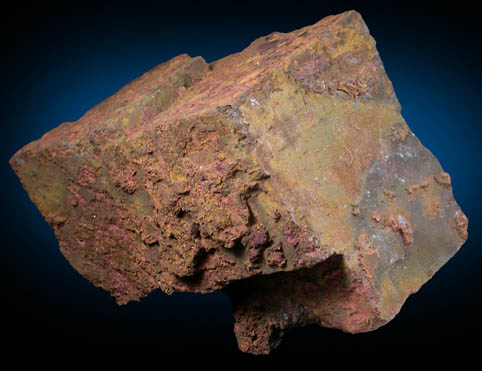
http://www.johnbetts-fineminerals.com/jhbnyc/mineralmuseum/picshow.php?id=57515
and a copper pseudomorph after aragonite. (picture from James St John, Wikipedia.) Regardless of what the raised relieves are, its presence should confirm the authenticity of the burial jade.

The article studies confirm nephrite chemical weathering secondary products. Chlorite has been reported, and it eventually alters into clay minerals Smectite and Kaolinite. The secondary products have also been described as ferruginous because of the high iron content. Iron secondary minerals are iron oxide Hematite, and iron hydroxide Goethite. MICHAEL ANTHONY VELBEL. WEATHERING OF HORNBLENDE TO FERRUGINOUS PRODUCTS BY A DISSOLUTION-REPRECIPITATION MECHANISM: PETROGRAPHY AND STOICHIOMETRY. Geochimica et Cosmochimica Acta Volume 45, Issue 11, November 1981, Pages 2123-2135.
References:-
1. Y. Noack, F. Colin, D. Nahon, J. Delvigne, and L. Michaux. Secondary-Mineral formation during Natural weathering of pyroxene: review and thermodynamic approach. American Journal of Science, Vol. 293, February 1993. P. 111 – 134.
2. M. Rozalen , M.E. Ramos F. Gervilla T. Kerestedjian S. Fiore F.J. Huertas .Dissolution study of tremolite and anthophyllite: pH effect on the reaction kinetics. Applied Geochemistry 49 (2014) 46-56
3. J. Cuadros. Clay crystal-chemical adaptability and transformation mechanisms. Clay minerals, (2012)47, 147-164.
4. D. Proust, J. Caillaud, C. Fontaine. Clay minerals in early Amphibole weathering: Tri- to Dioctahedral sequence as a function of crystallation sites in the Amphibole. The Clay Minerals Society, 2006.
5. D. Proust. Amphibole Weathering in a glaucophane-schist. Clay Mineral (1985) 20, 161-170
6. Aleksandra Daković, So this actually is wellAlessio Langella, and George E. Christidis. Clay crystal-chemical adaptability and transformation mechanisms. Clay Minerals, March 2015, v. 50, p. i-ii
7. JACQUES SCHOTT~, ROBERT A. BERNER and E. LENNART SJOHERGS. Mechanism of pyroxene and amphibole weathering-I. Experimental studies of iron-free minerals. Geochimica et Cosmochimica Acta Volume 45, Issue 11, November 1981, Pages 2123-2135
8. Robert A. Berner and Jacques Schott. Mechanism of pyroxene and amphibole weathering; II, Observations of soil grains. Am J Sci October 1, 1982 282:1214-1231; doi:10.2475/ajs.282.8.1214
9. Frederick A. Cook. Raised relief on nephrite jade artifacts: observations, explanations and implications. Journal of Arcaeological Science, 40 (2013) 943-954.
10. Mariola Marszałek, Zofia Alexandrowicz, and Grzegorz Rzepa. Composition of weathering crusts on sandstones from natural outcrops and architectonic elements in an urban environment. Environ Sci Pollut Res Int. 2014; 21: 14023–14036.
11. MICHAEL ANTHONY VELBEL. WEATHERING OF HORNBLENDE TO FERRUGINOUS PRODUCTS BY A DISSOLUTION-REPRECIPITATION MECHANISM: PETROGRAPHY AND STOICHIOMETRY. Geochimica et Cosmochimica Acta Volume 45, Issue 11, November 1981, Pages 2123-2135.
12. M. J . WILSON. Weathering of the primary rock-forming minerals: processes, products and rates. Clay Minerals (2004) 39, 233–266.
13. Jacques Schott. X-ray photoelectron studies of the mechanism of iron silicate dissolution during weathering. Geochimica et Cosmochimica Acta
Volume 47, Issue 12, December 1983, Pages 2233-2240.
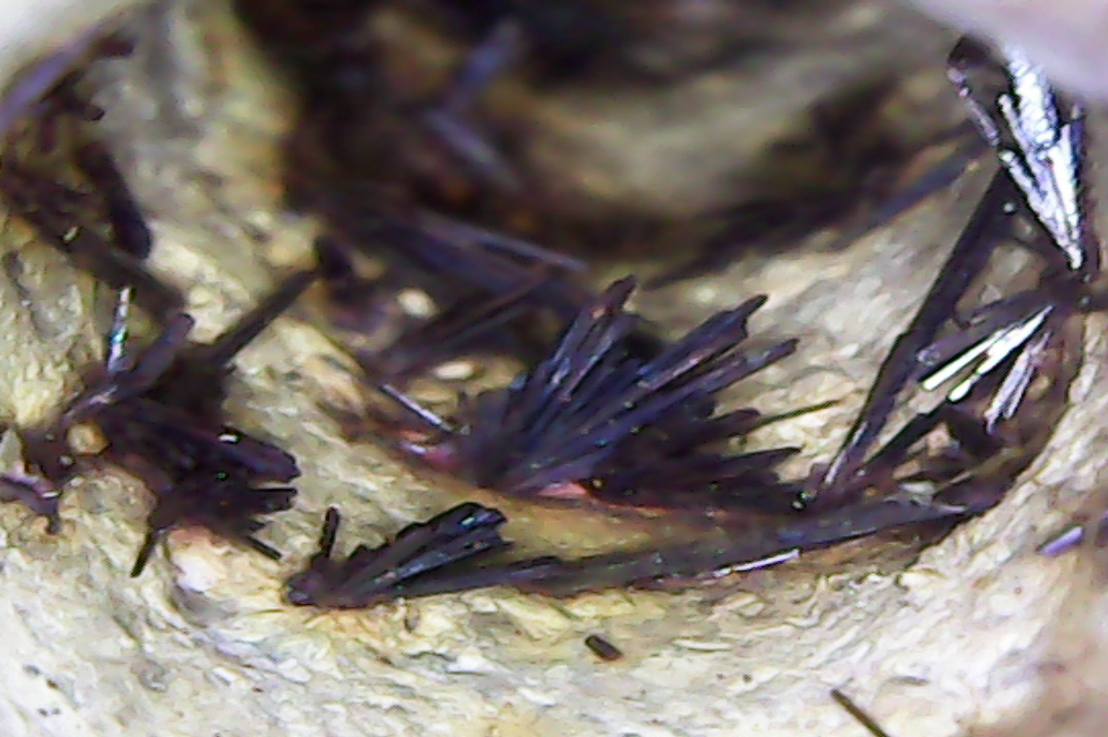












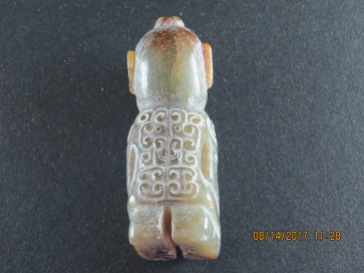


























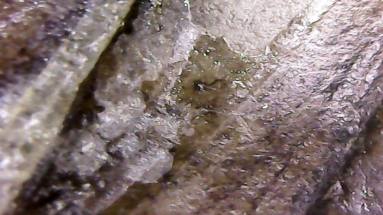

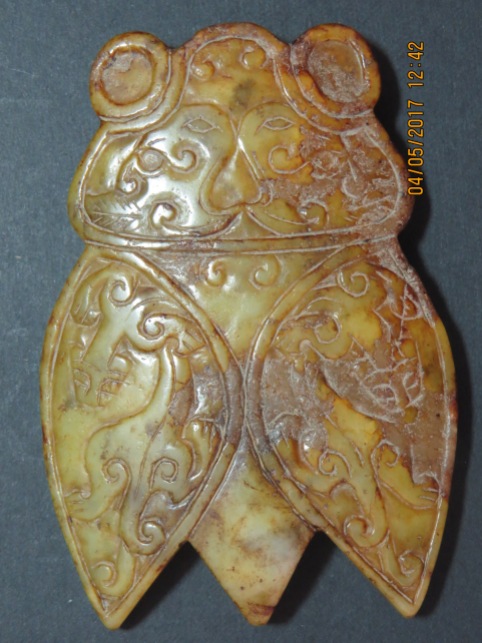




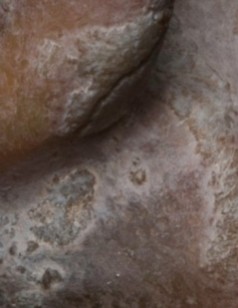

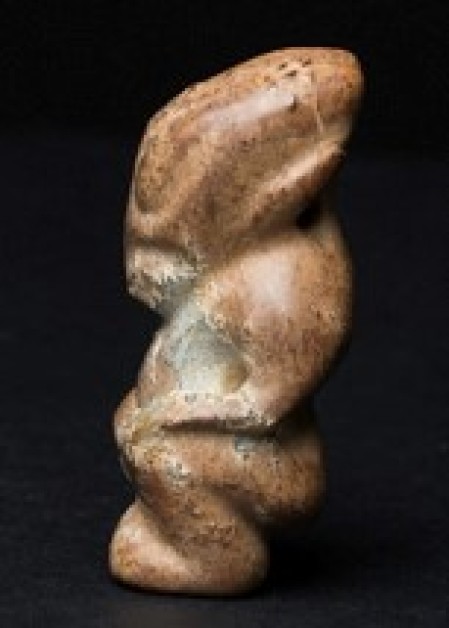

Thank you for knowledge and another piece to the puzzle
LikeLike
Thank you for your comment. My initial intention was to see if some scientific writings can come out in response to my writing. So far I have not seen one. There are however visits from around the world come in to read the paper, surprisingly including non English speaking countries like Germany, France , Sweden etc. There is no doubt, once the weathering secondary products, smectite, kaolinite, hematite and goethite can be identify on the buried nephrite surface, the real and the fake buried jade can be separated out. If you have any further comment or suggestions, please let me know.
LikeLike
Thank you for your visit. If you wish you can visit the site again. My new post is: The evolution of Chinese jade making from Neolithic to Han, The griffin winged beast and the Eurasia Stepp connection, and jades of the Tang Dynasty. Just go back to nephritejade-radixcultura. com and click on menu. All posts will come out.
LikeLike